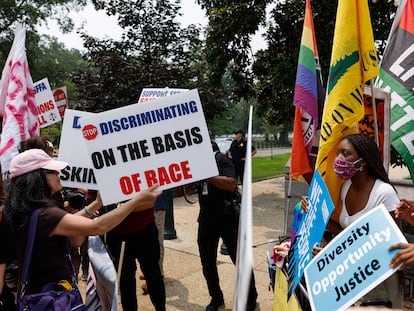Latinos outnumber non-Hispanic whites in Texas, according to 2022 census
In California and New Mexico they have long been in the majority, thanks to a steady increase in recent decades


The great fear of Trumpism, that the United States will stop being a white, English-speaking country, is on its way to becoming a reality. Latinos already outnumber non-Hispanic whites in Texas, according to the latest U.S. census data. Latinos (or Hispanics, the terms are interchangeable) represent around 40.2% of the population of Texas, slightly ahead of non-Hispanic whites, who account for 39.8% of the census. The trend is not limited to Texas, since in California and New Mexico Latinos have long been in the majority.
The results are not surprising, since the Latino population in Texas and in the country as a whole has increased steadily in recent decades. In 2020, the census revealed that just over a quarter of all children in the U.S. are Latino, an increase of more than a million in just a decade.
According to data from the Pew Research Institute, the U.S. Hispanic population reached 62.1 million in 2020, representing 19% of all Americans and the second-largest demographic group in the country. According to the same census, 39% of Californians were also Hispanic, slightly higher than whites (35%), as were 49.3% of New Mexicans. Therefore, there are three states where the Hispanic or Latino population is the majority. New Mexico has had the highest percentage of Hispanics since the end of the first decade of the century.
Texas’ demographic shift probably occurred around 2022, according to the Federal Census Bureau. For years, unofficial estimates had shown that Latinos were on track to outnumber non-Hispanic whites, reflecting decades of transformation. Of the estimated 12 million Latinos living in Texas, many are concentrated in San Antonio, the city with the highest percentage (around 64%).
After the 40.2% of the Texas population that is Latino or Hispanic, the next groups are “non-Hispanic whites” (39.8%), Black (13.4%), Asian (5.7%), two or more races (2.3%), American Indian/ Alaska Native (1.1%), and Native Hawaiian and other Pacific Islander (0.2%), according to the racial classification that is used almost on a daily basis in the U.S., where it is often mandatory to define yourself on the basis of race and ethnicity. The data comes from a census dated July 1, 2022. “The figures add up to more than 100% because Latinos can be of any race,” warn the official statistics, adding complexity to an identity that the Administration intends to define as unique.
Texas was mostly white from 1885 until 2004, when the non-Hispanic white population first fell below 50%. It is the second most populous state behind California, where people of color have represented 95% of its population growth in the last decade, according to the 2020 census. In Texas, California, Hawaii, Maryland, Nevada and New Mexico, non-Hispanic whites represent less than 50% of the population. Parallel to this demographic growth, the use of Spanish is also quickly advancing. It was the most widely spoken non-English language in American homes (62%) in 2019, 12 times more than the next four most common (Chinese, Tagalog, Vietnamese, and Arabic). More than half (55%) of Spanish speakers were born in the U.S.
Sign up for our weekly newsletter to get more English-language news coverage from EL PAÍS USA Edition
Tu suscripción se está usando en otro dispositivo
¿Quieres añadir otro usuario a tu suscripción?
Si continúas leyendo en este dispositivo, no se podrá leer en el otro.
FlechaTu suscripción se está usando en otro dispositivo y solo puedes acceder a EL PAÍS desde un dispositivo a la vez.
Si quieres compartir tu cuenta, cambia tu suscripción a la modalidad Premium, así podrás añadir otro usuario. Cada uno accederá con su propia cuenta de email, lo que os permitirá personalizar vuestra experiencia en EL PAÍS.
¿Tienes una suscripción de empresa? Accede aquí para contratar más cuentas.
En el caso de no saber quién está usando tu cuenta, te recomendamos cambiar tu contraseña aquí.
Si decides continuar compartiendo tu cuenta, este mensaje se mostrará en tu dispositivo y en el de la otra persona que está usando tu cuenta de forma indefinida, afectando a tu experiencia de lectura. Puedes consultar aquí los términos y condiciones de la suscripción digital.
More information
Archived In
Últimas noticias
There is as much life left to discover on planet Earth as that which is already known
Dozens presumed dead, around 100 injured in fire at Swiss Alps bar during New Year’s celebration
Is porn for women different from conventional porn? We spoke to those who make it
Cartagena de Indias is sinking: What can the city do to mitigate it?
Most viewed
- Reinhard Genzel, Nobel laureate in physics: ‘One-minute videos will never give you the truth’
- David King, chemist: ‘There are scientists studying how to cool the planet; nobody should stop these experiments from happening’
- Oona Chaplin: ‘I told James Cameron that I was living in a treehouse and starting a permaculture project with a friend’
- Sinaloa Cartel war is taking its toll on Los Chapitos
- The Interoceanic Train, the Mexican alternative to the Panama Canal










































